2009 Polaris Turbo Switchback Review
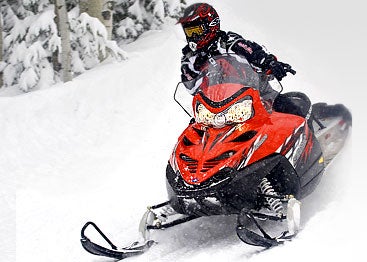
Turbo Switchback offers strengths to consider for off-trail riders
Let’s agree that on the face of it, the 2009 Polaris Turbo Switchback seems an unlikely choice for an off-trail, boondocking snowmobile. Frankly it’s probably not most riders’ first choice. But, dare we say, you should ride it first then make your decision.
Engine Type:Horizontal In-line
Cylinders:2
Engine Stroke:4-Stroke
Valve Configuration:OHV
Displacement:750 / 45.8
Starter:Electric
Turbocharged:Yes
View Full SpecOne thing that Polaris turbo-equipped snowmobiles have going for them is extremely smooth power delivery. The turbocharger pulls 60 more horsepower out of the rather modest base liquid-cooled, 750cc four-stroke twin cylinder engine. Polaris uses the 80-hp non-turbo engine in its touring and utility-oriented models. The turbo version powers a top of the line touring model, a high performance Dragon sports model and, of course, the 2009 Turbo Switchback.
First RideWe first rode Polaris turbo-equipped models a few years ago in the Utah Mountains and can say we were unimpressed. These were prototypes. At the time Polaris was behind in its 4-stroke engineering, especially in its mountain tuning of the turbo and non-turbo. In Utah the turbo versions suffered mightily from both the altitude and the abnormally warm spring temperatures. Since the turbo motor generates a lot of heat, Polaris engineers discovered underhood-heating problems that hadn’t shown up back home in the flatlands of Roseau County, Minn.
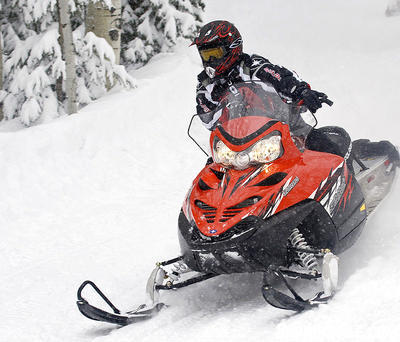 Polaris’ Turbo Switchback offers smooth power for on or off-trail adventure riding.
Polaris’ Turbo Switchback offers smooth power for on or off-trail adventure riding.
Already stung by the embarrassment of the Fusion fiasco, Polaris engineering suffered a double whammy as the turbo 4-stroke generated a myriad of problems in the hands of consumers. Learning from the Fusion mess, Polaris resolved to solve its turbo problems as quickly and quietly as it could. Whether turbocharged or not, the 4-stroke engine was an important piece of the Polaris engine arsenal and a significant factor in Polaris meeting evolving Environmental Pollution Agency standards for snowmobiles. Having a successful 4-stroke option in its product mix was a necessity.
Fortunately, issues with the turbo were fixable. Polaris engineering definitely took lemons and made lemonade as heading into 2009, the Polaris turbo 4-stroke is one of the easiest, smoothest and strongest engines you can have under the hood of a snowmobile. It has been a most pleasant surprise.
PWC PowerOur first encounter with the Polaris 4-stroke came just as the company was scuttling its personal watercraft line. Ironically, the craft that it scuttled was an all-new design and probably the best ever Polaris personal boat. But, hey, the market had shrunk and Polaris needed to put engineering effort and resources into its side-by-side UTVs and Victory motorcycles, both of which held much greater profit potential. Still, test riding the new turbocharged, 4-stroke watercraft gave us an insight into how the turbocharged engines might work in sleds.
Throttle response on the Polaris 4-strokes was impressive. The turbos showed negligible lag, which had been a common complaint about turbo-engined vehicles from cars to motorcycles. Having ridden Yamaha’s 650 turbo motorcycle back in the 1980s, we know how scary a sudden boost of power can be. With that early Yammie bike, you needed one eye on the road ahead and the other on the boost gauge. When the engine got to the red zone, the rear wheel was ready to light up the asphalt.
Weber Motor
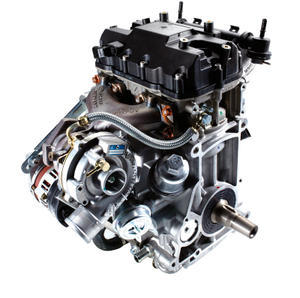 Adding an intercooled turbo pulls 140-hp out of this Weber-built 750cc four-stroke twin.
Adding an intercooled turbo pulls 140-hp out of this Weber-built 750cc four-stroke twin.
Originally the Weber/Polaris hook-up related to developing a marine engine for Polaris PWC. Of course, at the same time Polaris snowmobile engineers played with a Weber 4-stroke for sleds. The 2009 Turbo Switchback uses a derivative of that work.
One of the Weber MPE 750’s key features comes from its relative lightweight. The original mandate for the MPE 750 called for a power-to-weight ratio similar to a 2-stroke but with the fuel efficiency and clean burn of a 4-stroke. The base motor delivers 80 horsepower at about 8,000 revs, readily “clutch-able” for snowmobile use. The current 140-hp version ramps up to similar engine speeds, though the first Weber turbo engine for snowmobiles delivered five less ponies at just over 7,000 revs.
Conceived as a modular motor, the Polaris Weber-design suits recreational needs like snowmobiles, although there is an automobile-specific version used in Europe. The Polaris-Weber turbo relies on a Bosch system to control the turbo’s action. The intercooled turbo spools 14-pounds of boost so quickly you really can’t feel any turbo effect. All you know is that the 2009 Turbo Switchback is one potent machine.
When first introduced, the turbo version came with the same power as Polaris’ now-discontinued 700cc 2-stroke twin. The 2-stroke was lighter, but straightline performance could be a toss up. Polaris’ 4-stroke turbo (FST) is the real deal when it lines up for a run down a lake bed. Your 2-stroke buddies won’t be laughing when you reach lake’s end either ahead of them or right alongside. One thing we have seen firsthand is just how quick and fast the turbo 4-stroke truly is.
Weight Penalty
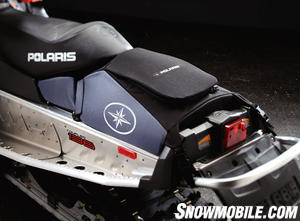 Storage is no problem with accessory tunnel bags.
Storage is no problem with accessory tunnel bags.
While the base 4-stroke twin was designed to be light and compact, the real world FST quickly adds weight with its intercooler turbo and ancillary plumbing. There’s more cooling paraphernalia, too. Remember we said Polaris engineering needed to solve heat issues? They did, but it came with a weight penalty.
When you compare the Turbo Switchback to the 800 Switchback equipped with Polaris’ latest 2-stroke technology, you’ll find 50 more pounds on the Turbo. Unfortunately, it feels like much of the added weight is over the skis. Maybe Polaris snowmobile engineers could borrow that nifty new Electronic Power Steering from the newest Ranger UTV. Oh, well!
The disadvantage to the Turbo Switchback is heft, all 598-lbs of it. That’s the Polaris claimed dry weight. Add in 10-plus gallons of fuel and you’ll really appreciate the turbo’s smooth torque characteristics.
While the Turbo Switchback is the heaviest of the Polaris off-trail models, it falls right in line with Yamaha’s off-trail 4-strokes. The top line Apex LTX and Vector LTX sandwich the Polaris Turbo Switchback. The Apex LTX has 10 more horses, weighs essentially the same but costs more. The 120-hp Vector LTX is 10 ponies shy of the Polaris turbo, weighs a titch less at 590-lbs and costs a few hundred less. When comparing 4-strokes to 4-strokes, the turbo Polaris comes off looking pretty good.
Shared Features
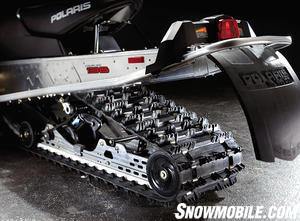 Pulling you off-trail is a 136-inch long RipSaw track with 1.25 inch lug profile.
Pulling you off-trail is a 136-inch long RipSaw track with 1.25 inch lug profile.
Keep in mind that this Switchback version shares the key ingredients of the standard 800 Switchback which includes a very ride-able stretched IQ 136 coupled rear suspension complete with high-pressure gas shocks and up to 14-inches of travel. Surrounding the parallel rail setup is a 136-inch Ripsaw profile track with 1.25 inch lug height.
The front suspension offers up to 10-inches of travel from its gas-shock equipped IQ design. Ski stance measures 42.5 inches from center to center for smooth cornering efficiency.
Unlike other Polaris Switchback models, the 140-hp turbo outfit comes complete with Rider Select handlebar setup with up to seven position settings and the Freestyle seat for free movement off trail.
Test Ride
Compared to its Switchback brethren, the Turbo Switchback is a tad hefty, but it is extremely smooth. You might actually find that the turbo engine excels in certain snow conditions that cause 2-stroke boondockers to falter. You should also expect better fuel economy overall and no need to add oil except for the annual oil change. Plus, if you tend to do more on-trail riding than actual off-trail boondocking, you owe it to yourself to check out the Turbo Switchback. For 2009 we feel that Polaris has this sled fully sorted out for the better. As we said early on, before you make up your mind as to which off-trail sled to buy, you should test ride this sled because it offers some benefits you won’t find in Polaris’ other off-trail adventure models.
| 2009 Polaris Turbo Switchback Specs | |
| Engine | Polaris/Weber 750cc, intercooled turbocharger, 4-stroke, twin cylinder; liquid-cooled; fuel injection; |
| Horsepower | 140 |
| Drive | Polaris P-85 drive; P2 driven |
| Front Suspension | Polaris IQ 10-in maximum travel; RydeFX gas shocks |
| Rear Suspension | Polaris IQ 136 Coupled 14-in of maximum travel; RydeFX on front arm, Fox PS5 on rear |
| Length | 120.0 in |
| Width | 48.0 in |
| Ski Stance | 42.5 in |
| Track | 15 x 136 x 1.25 RipSaw |
| Weight | 598 lbs |
| Fuel Capacity | 10.2 US Gal |
| MSRP | US $9,999 |




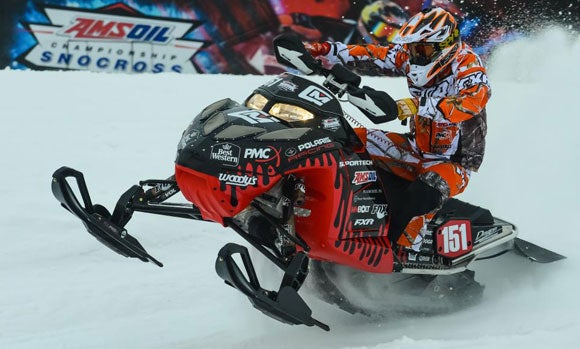



 Your Privacy Choices
Your Privacy Choices